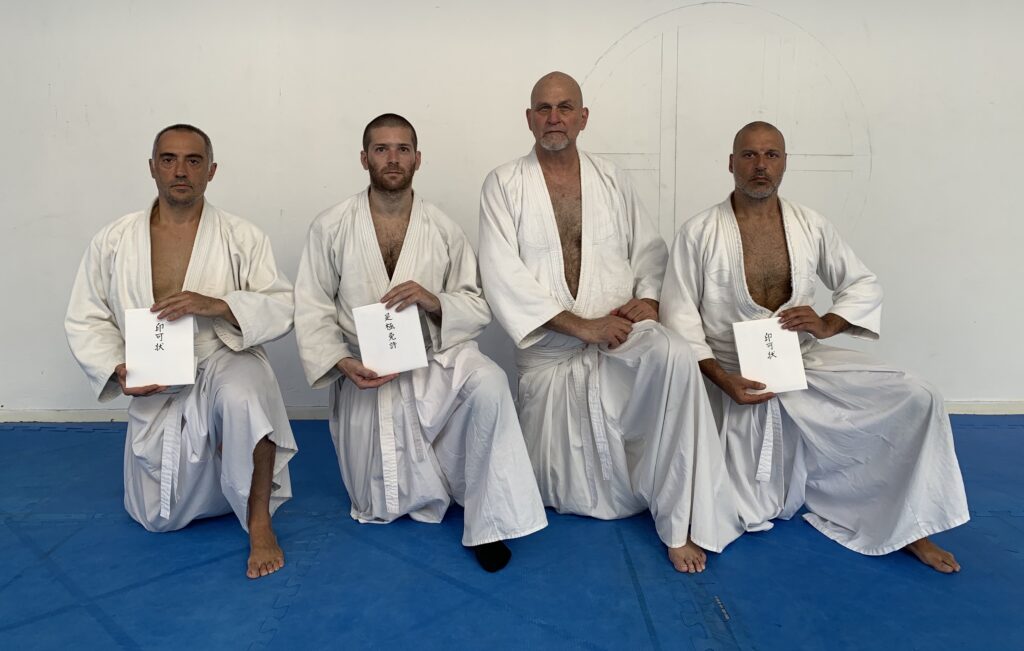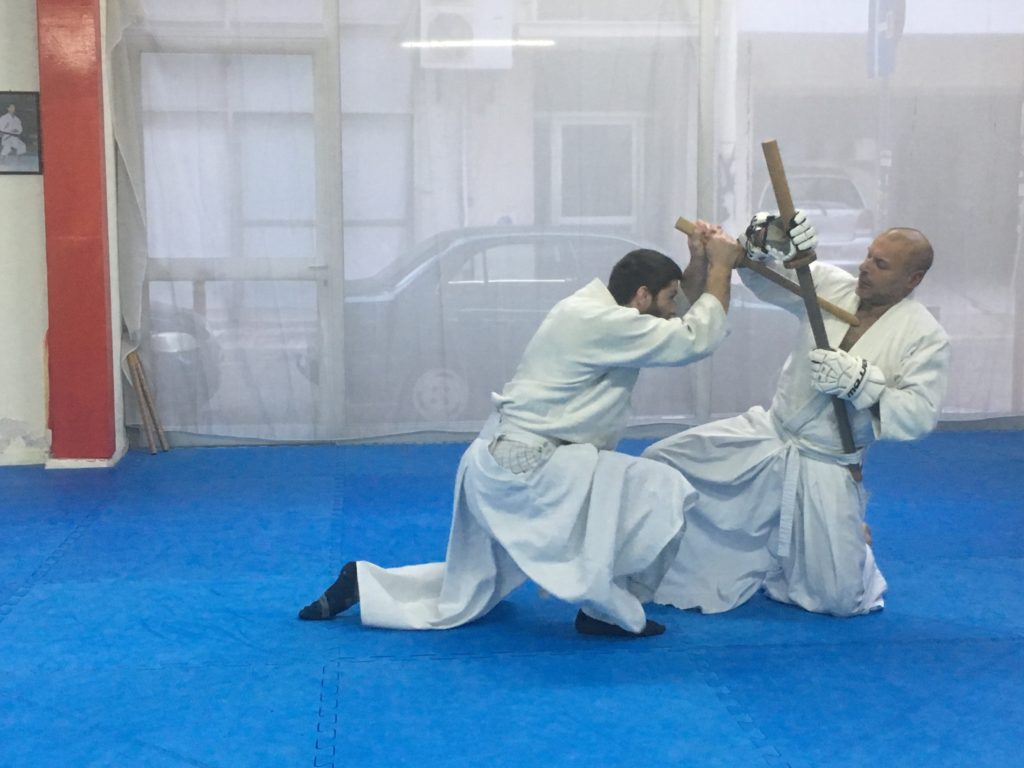United States
Ellis Amdur maintains a small group of long time training associates, with whom he’s had a many year history, working more in the sense of a collaboration between peers rather than a formal dōjō. He is not taking on new students in Araki-ryū torite-kogusoku (see below for a discussion of Taikyoku Araki-ryū).
Europe
Greece is currently the center of Ellis Amdur’s lineage of Araki-ryū torite-kogusoku.
Athens, Greece: practice is under the direction of 20th generation shihan Thanassis Bantios, and shihandai, Leonidas Gouliotis & shihandai Giorgos Chronopoulos. Inquiries should be directed to Thanassis Bantios.
Thessaloniki, Greece – practice is under the supervision of shihan Thanassis Bantios, and shihandai Leonidas Gouliotis & shihandai Giorgos Chronopoulos. Inquiries should be directed to Stratos Karpouzidis.

Taikyoku Araki-ryu
Amdur is teaching several established martial arts groups, who center their own practice around Brazilian jiujitsu, judō, and/or MMA, under the rubric of Taikyoku Araki-ryū. (太曲荒木流). Selected portions of the Araki-ryū curriculum is taught to each group (hence the word taikyoku, which can mean ‘ significant modules.’) This is an end in itself: that section alone is taught in its entirety. For example, one group is training in a section of the staff curriculum, the sword curriculum and a portion of the torite. Upon completion, if the group and Amdur so wish, another module may be taught. Conceivably, if they prove dedicated to training, and are willing to give up the many years and daily hours of training necessary, they could work ‘module by module’ and learn the entire ryu and they would then be doing Araki-ryū torite-kogusoku. On the other hand, through this teaching methodology, a group can train with full intensity, without the obligation to commit at least a decade of one’s life and many hours a day to learn the complete curriculum. At this point in time, the only two groups are in Pacific Northwest and Palos Verdes, California . The only way to train in this methodology is either in one of these two groups, or by setting up a group of your own that fits all criteria for training. I am not teaching individual students. See the Taikyoku Araki-ryū website for more information.
Prerequisites – The Body
The baseline of Araki-ryū is physical power. Some martial arts make claims that physical power is irrelevant, even an impediment. Araki-ryu is not among them. If you do not have a powerful body (by these we mean ‘farmer’s strength, laborer’s strength, grappler’s strength rather than “gym muscles”), you will not be accepted in Araki-ryū
A pre-requisite for training in Amdur’s line of Araki-ryū is skill in body-to-body grappling: judō, free-style or Greco-Roman wrestling, sambo, BJJ, sumō, etc. There are no exceptions to this requirement. The physical dynamics of Araki-ryū are identical to that of body-to-body wrestling, and requires the same kind of fluid adaptability to rapidly changing force. ‘Arms-length grappling,’ such as aikidō, Daitō-ryū, Hakkō-ryū, or many modern styles of European/American jūjutsu that do not work body-to-body, does not suffice. (Please understand that these styles are great practices in-and-of themselves. If you are skilled in such arts, some of what you’ve learned may well contribute to your learning Araki-ryū. However, Araki-ryū is developed by body-to-body, connected grappling.)
If you are interested in joining Araki-ryū and do not have these skills, first enroll in a school that teaches free-style, competitive grappling. After a period of at least six months of regular practice (training that you would continue irregardless of whether you enter the ryūha or not), then inquire about entry into Araki-ryū (see above). If you are accepted into the rryūyu, you will be expected to continue your training in free-style grappling. If you do not love grappling for its own sake–and would only enroll in hopes of entering Araki-ryū–you are not suitable for training.
NOTE: the Athens Hokusei Dojo offers training in body-to-body grappling.
Prerequisites – The Mind
If you find yourself intrigued by Japanese martial traditions, and in particular, Araki-ryū, it is important that you get some idea of what koryū really is. Training is a serious commitment – it would be unfortunate if you went through a rigorous process to enter this ryū and found that it was not at all what you expected. Therefore, you should read the following before contacting the ryū.
1. Old School: Essays on Japanese Martial Traditions – Expanded Edition
2. Kogenbudo.org
Curriculum
The Araki-ryū curriculum includes the following:
Torite: Armed grappling in which the attacker takes a dominant position to subdue the opponent
Kogusoku: This includes grappling techniques where the practitioner:
- counters a superior force or weapon
- sword drawing and attack (bakken)
- armed grappling with short sword against long sword
Toren: Weaponry – there are four subsets
- Hamono – kenjutsu & kodachijutsu
- Emono – bojutsu, naginatajutsu, & nagamakijutsu
- Kusarimono – kusarigamajutsu, chigirikjutsu & ryofundojutsu
- Sasumono – sojutsu
The central method of practice is two-person forms known as kata. However, there are also a number of necessary solo training methods to build power, technique and proper physical organization.
Araki-ryū also attempts to make the kata more powerful through ‘live’ practice – at higher levels, practitioners ‘break’ the kata if they perceive an opening in their opponent’s technique. Furthermore, movements are isolated out from a form and used as a jumping-off point for various forms of semi-freestyle training – one might respond to a specific attack with any one of a number of techniques, rather than the one ‘programmed’ in that sequence of the kata. The reverse can also be enacted – one must use a single technique to defend against a variety of attacks.
The goal of these and other training methods is to practice in a way that will hone one’s skills to the highest level. The dilemma of simply practicing in pure freestyle – as opposed to different forms of limited sparring – is that most of the practice weapons, made of hardwood, are so heavy that any mistake would be devastating. If the weapons are lightened, one loses one’s fear of injury and reacts in an unnatural fashion. Imagine a circle with a center point designating pure life-and-death combat. If one draws lines through that center point, one has a design much like a pie-chart, with each section representing one training method that allows one to concentrate intensely on one or two requirements for combat, in a way that does not require the participants to put themselves at excessive risk of permanent injury.

In so-called freestyle, one is either in combat, or one is sparring – in which safety is merely ensured in a manner other than that in kata training. Furthermore, one can easily lapse into sports point scoring, in which footwork and weapon usage suitable to a light weapon in a training hall supplant the low postures and physical organization necessary to wield a heavy weapon on uneven ground, and other adverse conditions.
That said, such training as grappling, boxing or kick boxing, in which one strives against a fully resisting opponent, albeit within rules, is also an essential experience. One learns something about oneself in a manner that is impossible to achieve otherwise. In addition, the experience of adaptation to the unscripted movements of the opponent, who is simultaneously striving to disrupt or defeat your technique is a skill that is transferrable to weapons training where pure freestyle is impossible outside combat.
Our Araki-ryu strives to study a method of using the body and weaponry in which hand-to-hand/body-to-body and weapon usage are melded into a single practice, where one develops the improvisational adaptability that is inherent in the best grapplers.
An Explanation of Certification in the Curriculum of the Hokusei Dojo
When participants have sufficiently learned a section the ryu, they are given a certificate of recognition of that level of skill. This is principle based, rather than a note that one has learned certain kata. This is not a teaching license.
- Kirigami
- Mokuroku
- Inka
- Zegoku-menkyo
Teaching certification is separate from the above. There are two levels:
- Shihan-dai – at this level, the person has permission to teach under the authority of Ellis Amdur. This license does not grant any independent authority to teach, and is never a certification of complete transmission of the curriculum or mastery of the ryū. The shihan-dai is considered to be a ‘student-instructor’ – and part of his/her learning process is the permission to begin teaching under supervision. If a person quits or is expelled from the ryū, their shihan-dai authority is terminated.
- Shihan – at this level, one has received the complete transmission of the ryu, and has independent authority to set up his or her own dojo.
All certificates of attainment and/or teaching licenses from the Hokusei Dōjō will have the proper hanko (name seal), and are written entirely in Japanese. Any rank by any other appellation, with an improper seal, or any certificate written in English, has absolutely no validity in terms of this particular lineage.
Any questions about the certification of any individual who is said to be associated with this line of Araki-ryu, either present or by history, can be directed to Ellis Amdur.
